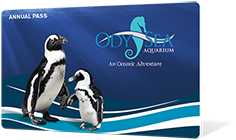SCOTTSDALE, AZ – Feb. 27, 2020 – OdySea Aquarium is celebrating the birth of four healthy sandbar shark pups (babies) that took place in its OdySea Voyager exhibit last Thursday, February 20. The gender of the pups are two males and two females. Sandbar sharks successfully born under human care are a very rare occurrence; less than 10 known recorded births have taken place in the United States.
“So much effort went on behind-the-scenes to ensure the best possible outcome for these shark pups,” said Lance Ripley, Animal Care Curator at OdySea Aquarium. “We are fortunate to have a very experienced team caring for our sharks; we worked together to execute a well-thought-out plan that resulted in four successful births. We are ecstatic to see our hard work, dedication and commitment pay-off to help advance the conservation of this species.”
Last spring, the Animal Care team observed breeding behavior between two of our sandbar sharks—a strong indication that the animals are comfortable and thriving in their care at OdySea Aquarium. After an ultrasound performed by OdySea Aquarium’s veterinarian confirmed the female was expecting, the Animal Care team began to develop an extensive undertaking to allow the female shark to carry out her gestation (pregnancy) and give birth to what was expected to be several offspring. When first born, sandbar shark pups are incredibly vulnerable to predators, so the focus was on creating an environment where the pregnant shark would feel safe, surrounded by animals that would pose no threat to her or her pups. Over the course of several weeks, the team temporarily relocated over a dozen animals including sea turtles, stingrays and very large groupers (some of these animals weighed up to 250 pounds), giving the female shark ample space and suitable companions in the OdySea Voyager exhibit.
“Our meticulous plans and careful moves were well worth it; the four births at OdySea Aquarium are an extremely significant milestone toward understanding the natural history of this shark species,” said Dave Peranteau, Director of Animal Care and Conservation at OdySea Aquarium. “We believe sharks should be revered and not feared and the successful births allow us to help safeguard sharks for generations to come.”
After the births, the Animal Health and Animal Care teams monitored the pups for several hours on exhibit before the four babies were moved behind-the-scenes for additional veterinary assessment and further observation. Sandbar sharks provide no maternal care and pups are on their own immediately upon birth. The Animal Health and Animal Care teams are working closely to oversee the baby sharks’ well-being and growth. Mom is doing well and remains on exhibit for guests to see. Currently, the shark pups are about two feet in length, eating well, and hitting all developmental milestones. This stocky shark, also known as a brown shark, can weigh up to 200 pounds as an adult and reach up to 7.5 feet in length.
The sandbar shark is found in coastal waters of temperate and tropical regions around the world. While it is the most abundant shark in the Western Atlantic, it is listed as Vulnerable on the International Union for the Conservation of Nature’s Red List (IUCN). It is caught for its fins, oil, skin, and meat and is targeted in some fisheries. Their slow growth, late sexual maturity, and few numbers of offspring make them a sensitive species to overfishing.
“We are aware that successful births of this species are very rare under human care but we remain cautiously optimistic and excited about their progress thus far,” said Dr. Eric Anderson, Head Veterinarian and Director of Animal Health. “Our priority is to give the animals the best healthcare possible and learn as much as we can from this experience. It was a huge undertaking to prepare for this birth, and everyone involved feels like proud parents to our newest OdySea Aquarium babies.”
The pups will remain behind-the-scenes until they have achieved substantial growth and maturity. However, “Pup-dates” on the four baby sharks will be posted regularly to OdySea Aquarium’s Facebook page letting fans know about their important milestones along with updated photos. Plans are underway to return all the animals that were relocated during this time to their original habitats.










